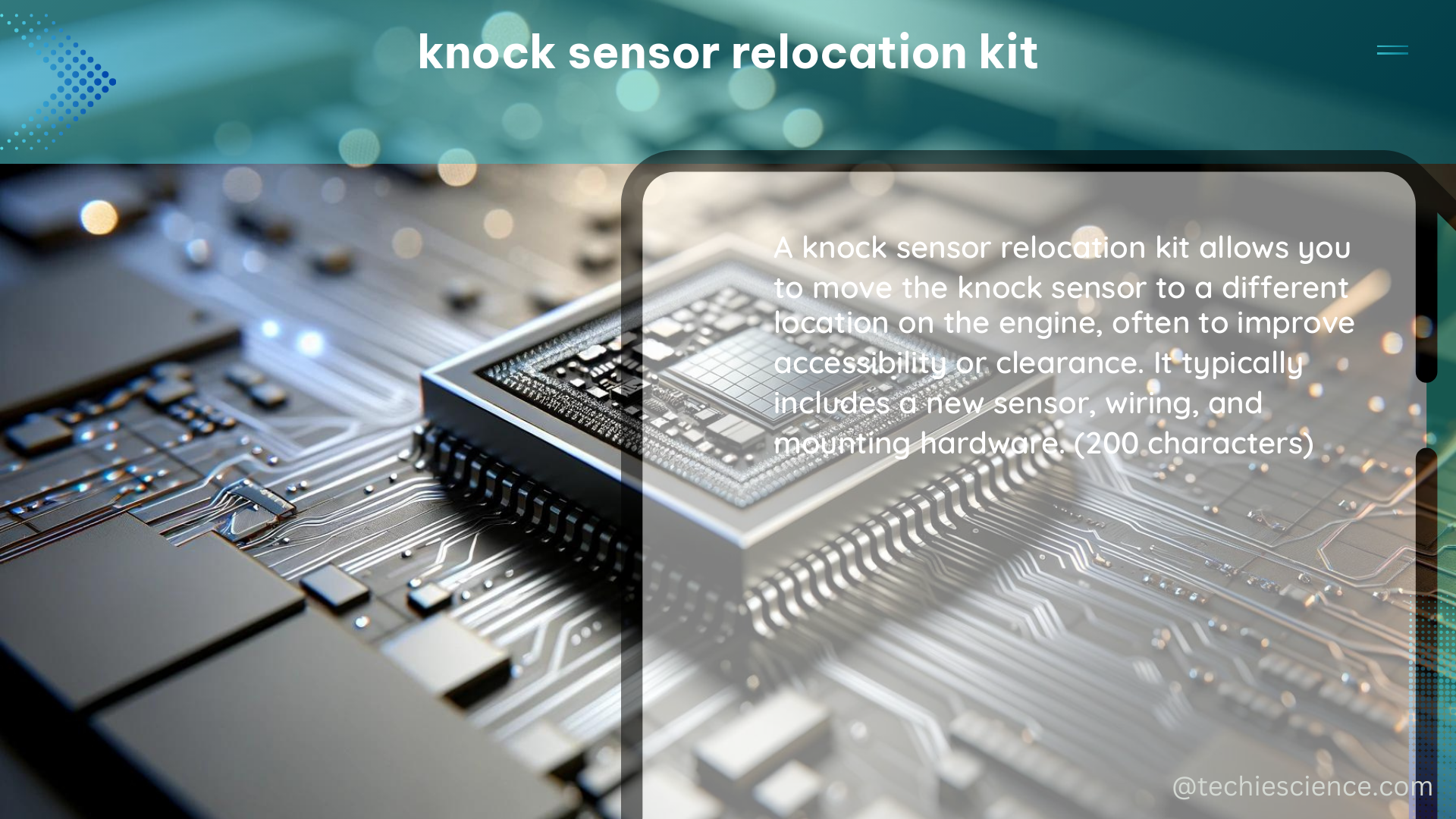Knock sensor relocation kits are a popular modification among performance-oriented enthusiasts, as they allow for the repositioning of the knock sensor to improve its functionality and enhance engine performance. The knock sensor is a critical component in an engine’s knock detection system, responsible for protecting the engine from damaging knocking or pinging sounds caused by improper fuel-air mixtures or ignition timing.
Understanding the Importance of Knock Sensor Relocation
The location of the knock sensor is crucial for accurate knock detection. When relocating the sensor, it’s essential to choose a position that provides clear signals and accurate readings. Unused holes on the side of the engine block are commonly used for relocation, as they offer a secure and accessible mounting point. Alternatively, some enthusiasts opt to drill and tap the block directly, though this approach requires more advanced fabrication skills.
Factors to Consider When Relocating the Knock Sensor

-
Signal Quality: Relocating the knock sensor can affect the signal quality, which can impact the engine’s ability to detect knock. Ensuring that the new location provides a clear and accurate signal is crucial for proper engine operation.
-
ECM Adjustments: Relocating the knock sensors may require adjustments to the engine control module (ECM) to ensure accurate knock detection and proper engine operation. This step is often overlooked but can have a significant impact on the engine’s performance and reliability.
-
Diagnostic Trouble Codes (DTCs): Relocating the knock sensor can result in diagnostic trouble codes, such as P0328 or P0327, which indicate an issue with the knock sensor circuit. These codes should be addressed to ensure proper engine operation and avoid potential engine damage.
-
Performance Gains: Relocating the knock sensor can potentially result in performance gains, such as increased horsepower and torque, by allowing the engine to operate at higher RPMs without triggering the knock sensor. However, the extent of these gains may vary depending on the specific application and engine setup.
Technical Specifications of Knock Sensor Relocation Kits
When selecting a knock sensor relocation kit, consider the following technical specifications:
-
Material: The material of the relocation kit should be durable and able to withstand the harsh conditions of the engine bay. Stainless steel or aluminum are common materials used for relocation kits, offering corrosion resistance and high strength-to-weight ratios.
-
Fitment: The relocation kit should be designed to fit the specific make and model of the engine, ensuring a secure and accurate fit. Poorly fitting kits can lead to sensor misalignment and inaccurate readings.
-
Ease of Installation: The relocation kit should be relatively easy to install, with clear instructions and all necessary hardware included. This can save time and reduce the risk of installation errors.
-
Signal Quality: The relocation kit should be designed to maintain or improve signal quality, ensuring accurate knock detection and proper engine operation. Some kits may incorporate features like vibration dampening or shielding to enhance signal integrity.
-
Adjustability: Some relocation kits offer adjustability, allowing for fine-tuning of the sensor’s position for optimal signal quality and accuracy. This can be particularly useful when dealing with complex engine configurations or tight packaging constraints.
DIY Guide for Installing a Knock Sensor Relocation Kit
-
Locate the Knock Sensor: Identify the location of the knock sensor on the engine block. This is typically on the side of the block, near the cylinder head.
-
Remove the Sensor: Carefully remove the knock sensor from its current location, taking care not to damage the sensor or the surrounding area. Consult the manufacturer’s instructions for the proper removal procedure.
-
Prepare the New Location: Clean and prepare the new location for the sensor, ensuring a secure and accurate fit. This may involve drilling and tapping the block, or utilizing an existing unused hole.
-
Install the Relocation Kit: Install the relocation kit according to the manufacturer’s instructions, ensuring a secure and accurate fit. This may involve the use of specialized tools or hardware, such as thread sealant or high-strength adhesives.
-
Reconnect the Sensor: Reconnect the knock sensor to the engine control module (ECM) and ensure a secure and accurate connection. Refer to the manufacturer’s wiring diagrams or schematics for the proper connection procedure.
-
Test the Sensor: Test the knock sensor to ensure proper operation and accurate readings. This may involve using a multimeter or a specialized diagnostic tool to verify the sensor’s output and functionality.
-
Clear Diagnostic Trouble Codes (DTCs): Clear any diagnostic trouble codes related to the knock sensor circuit to ensure proper engine operation. Failure to do so may result in the engine’s check engine light illuminating or other performance issues.
By following this comprehensive guide, you can successfully install a knock sensor relocation kit and optimize your engine’s performance, while ensuring the long-term reliability and protection of your engine’s critical components.
Reference:
- Knock sensor relocation – LS1TECH – Camaro and Firebird Forum
- Knock sensor relocation thoughts and questions – B15 Sentra Forum
- relocating the knock sesnors from under intake to side of block – HPTuners Forum

The lambdageeks.com Core SME Team is a group of experienced subject matter experts from diverse scientific and technical fields including Physics, Chemistry, Technology,Electronics & Electrical Engineering, Automotive, Mechanical Engineering. Our team collaborates to create high-quality, well-researched articles on a wide range of science and technology topics for the lambdageeks.com website.
All Our Senior SME are having more than 7 Years of experience in the respective fields . They are either Working Industry Professionals or assocaited With different Universities. Refer Our Authors Page to get to know About our Core SMEs.